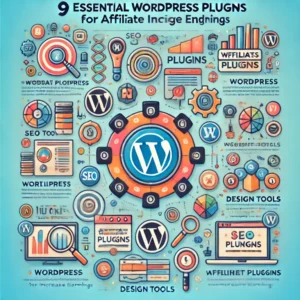If you’re just starting your website, you’ve probably heard of SEO, but how do you actually use it to drive traffic to your site? This guide will walk you through the key aspects of Search Engine Optimization (SEO), so your website gets noticed by search engines and visitors alike.
What is SEO and Why Is It Important?
SEO (Search Engine Optimization) is the process of optimizing your website to rank higher on search engine results pages (SERPs). When done right, SEO helps you attract organic traffic, which means people find your site naturally through search engines like Google, Bing, and Yahoo.
Without SEO, your website is likely to remain invisible to your target audience. Effective SEO ensures:
- More traffic to your website
- Increased visibility and brand awareness
- Higher chances of conversions and sales
How Do Search Engines Work?
Search engines use bots (also known as spiders or crawlers) to scan and index web pages. They analyze the content, structure, and relevance of your website before ranking it in response to user queries. To optimize your site for this process, you need to implement both on-page and off-page SEO tactics, which we will cover below.
Step 1: Keyword Research – The Foundation of SEO
The first step in any successful SEO strategy is keyword research. Keywords are the terms and phrases that people type into search engines when looking for information.
How to Do Keyword Research
- Start with a list of broad topics related to your website or niche.
- Use tools like:
- Google Keyword Planner
- Ubersuggest
- AnswerThePublic
- SEMrush
- Look for long-tail keywords—phrases with lower competition but high intent. These are often easier to rank for and more specific to your audience’s needs.
Example: Instead of targeting “fitness tips” (very competitive), use a long-tail keyword like “beginner fitness tips for home workouts.”
Integrating Keywords Into Your Website
Once you have a list of relevant keywords, strategically place them in:
- Page titles (H1)
- Subheadings (H2, H3)
- Meta descriptions
- Image alt tags
- Body content
Pro Tip: Avoid keyword stuffing. Use keywords naturally in your content to enhance readability.
Step 2: On-Page SEO – Optimizing Your Website Content
On-page SEO refers to the elements on your website that you can control, such as the content, design, and structure.
Best Practices for On-Page SEO
- Create High-Quality Content: Content is the heart of SEO. Write detailed, informative, and engaging content that solves your audience’s problems or answers their questions.
- Optimize Meta Titles and Descriptions: Each page and post on your website should have a unique meta title and meta description that includes your target keyword. This not only helps with SEO but also improves your click-through rate (CTR).
- Use Headings Effectively: Break up your content using heading tags (H1 for the main title, H2 for subheadings). This makes your content easier to read and helps search engines understand its structure.
- Internal Linking: Link to other relevant pages on your website to improve navigation, reduce bounce rates, and distribute ranking power across your site.
- URL Structure: Keep URLs short, descriptive, and include your main keyword. For example, instead of “yourwebsite.com/post123,” use “yourwebsite.com/seo-tips-for-beginners.”
Step 3: Technical SEO – The Backbone of a Well-Optimized Site
Even if your content is great, if your site has technical issues, it won’t rank as well as it could. Technical SEO ensures that your website is accessible and easy for search engines to crawl and index.
Key Technical SEO Elements:
- Site Speed: A fast-loading site is crucial for both SEO and user experience. Use tools like Google PageSpeed Insights to measure and improve your site’s speed.
- Mobile Friendliness: With over 50% of internet traffic coming from mobile devices, having a responsive design that works on all screen sizes is essential.
- SSL Certificate: Make sure your site is secure (HTTPS), as Google gives preference to secure websites.
- Sitemaps: Create and submit an XML sitemap to Google Search Console. This helps search engines discover and index your content.
- Fix Crawl Errors: Regularly check Google Search Console for crawl errors and fix them to ensure your site is fully indexed.
Step 4: Off-Page SEO – Building Authority with Backlinks
Off-page SEO involves improving your website’s reputation and authority by earning backlinks from other sites. The more high-quality links you have pointing to your site, the more credible search engines perceive it to be.
How to Build Backlinks:
- Guest Blogging: Write guest posts for other websites in your niche and include a link back to your site.
- Content Promotion: Share your content on social media and reach out to influencers or bloggers who might find it useful.
- Directory Submissions: Submit your site to relevant online directories.
- Broken Link Building: Find broken links on other websites and offer your content as a replacement.
Remember: Quality is more important than quantity when it comes to backlinks. A single link from a high-authority site (like a major publication) is worth more than multiple links from low-authority sites.
Step 5: Monitoring and Adjusting Your SEO Strategy
SEO is not a “set it and forget it” task. You need to continually monitor your site’s performance and make adjustments based on data.
Tools for Tracking SEO Performance:
- Google Analytics: Use this tool to track website traffic, user behavior, and conversions.
- Google Search Console: Monitor your keyword rankings, find indexing issues, and see which queries bring users to your site.
- Ahrefs or SEMrush: Track your backlink profile, competitors, and keyword rankings over time.
Regular SEO Audits:
Perform regular audits of your site to check for:
- Broken links
- Outdated content
- Technical issues (e.g., crawl errors)
- Opportunities to improve keyword targeting
By regularly reviewing your site’s performance, you can stay ahead of the competition and ensure your site continues to rank well in search results.
Conclusion
SEO is essential for driving organic traffic to your website and improving its visibility in search engines. By following the steps outlined in this guide—keyword research, on-page and technical optimization, off-page SEO, and continuous monitoring—you’ll set your website up for long-term success.
Remember, SEO is a marathon, not a sprint. It takes time and effort, but with patience and persistence, you’ll see your website climb the rankings and attract the audience you want.


